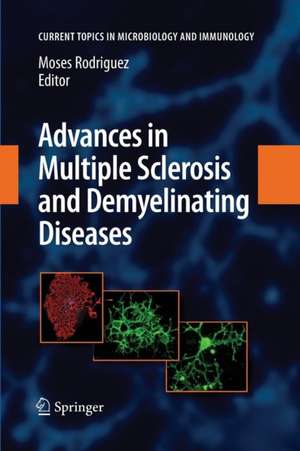Advances in Multiple Sclerosis and Experimental Demyelinating Diseases: Current Topics in Microbiology and Immunology, cartea 318
Editat de Moses Rodriguezen Limba Engleză Paperback – 25 sep 2014
| Toate formatele și edițiile | Preț | Express |
|---|---|---|
| Paperback (1) | 1098.84 lei 6-8 săpt. | |
| Springer Berlin, Heidelberg – 25 sep 2014 | 1098.84 lei 6-8 săpt. | |
| Hardback (1) | 1107.58 lei 6-8 săpt. | |
| Springer Berlin, Heidelberg – 5 dec 2007 | 1107.58 lei 6-8 săpt. |
Din seria Current Topics in Microbiology and Immunology
- 18%
 Preț: 962.03 lei
Preț: 962.03 lei - 5%
 Preț: 1123.13 lei
Preț: 1123.13 lei - 5%
 Preț: 1085.95 lei
Preț: 1085.95 lei -
 Preț: 499.77 lei
Preț: 499.77 lei - 5%
 Preț: 967.81 lei
Preț: 967.81 lei - 18%
 Preț: 1118.62 lei
Preț: 1118.62 lei - 5%
 Preț: 717.00 lei
Preț: 717.00 lei - 5%
 Preț: 712.97 lei
Preț: 712.97 lei - 5%
 Preț: 709.51 lei
Preț: 709.51 lei - 5%
 Preț: 709.51 lei
Preț: 709.51 lei - 5%
 Preț: 721.19 lei
Preț: 721.19 lei - 5%
 Preț: 359.78 lei
Preț: 359.78 lei - 5%
 Preț: 711.88 lei
Preț: 711.88 lei - 5%
 Preț: 774.81 lei
Preț: 774.81 lei - 15%
 Preț: 640.06 lei
Preț: 640.06 lei - 5%
 Preț: 717.00 lei
Preț: 717.00 lei - 5%
 Preț: 360.34 lei
Preț: 360.34 lei - 5%
 Preț: 707.69 lei
Preț: 707.69 lei - 5%
 Preț: 717.56 lei
Preț: 717.56 lei - 5%
 Preț: 716.28 lei
Preț: 716.28 lei - 5%
 Preț: 717.20 lei
Preț: 717.20 lei - 5%
 Preț: 711.32 lei
Preț: 711.32 lei - 5%
 Preț: 711.88 lei
Preț: 711.88 lei - 5%
 Preț: 718.29 lei
Preț: 718.29 lei - 5%
 Preț: 709.51 lei
Preț: 709.51 lei - 5%
 Preț: 369.84 lei
Preț: 369.84 lei - 5%
 Preț: 712.25 lei
Preț: 712.25 lei - 5%
 Preț: 716.45 lei
Preț: 716.45 lei - 5%
 Preț: 706.60 lei
Preț: 706.60 lei - 5%
 Preț: 711.52 lei
Preț: 711.52 lei - 5%
 Preț: 713.54 lei
Preț: 713.54 lei - 5%
 Preț: 720.47 lei
Preț: 720.47 lei - 5%
 Preț: 725.42 lei
Preț: 725.42 lei - 5%
 Preț: 708.06 lei
Preț: 708.06 lei - 5%
 Preț: 713.70 lei
Preț: 713.70 lei - 5%
 Preț: 705.83 lei
Preț: 705.83 lei - 5%
 Preț: 710.96 lei
Preț: 710.96 lei - 5%
 Preț: 723.93 lei
Preț: 723.93 lei - 5%
 Preț: 707.69 lei
Preț: 707.69 lei - 5%
 Preț: 715.35 lei
Preț: 715.35 lei - 5%
 Preț: 709.87 lei
Preț: 709.87 lei - 5%
 Preț: 359.05 lei
Preț: 359.05 lei - 5%
 Preț: 374.20 lei
Preț: 374.20 lei - 15%
 Preț: 635.31 lei
Preț: 635.31 lei - 5%
 Preț: 707.86 lei
Preț: 707.86 lei - 5%
 Preț: 721.96 lei
Preț: 721.96 lei - 15%
 Preț: 632.88 lei
Preț: 632.88 lei - 15%
 Preț: 632.05 lei
Preț: 632.05 lei - 15%
 Preț: 642.83 lei
Preț: 642.83 lei
Preț: 1098.84 lei
Preț vechi: 1156.67 lei
-5% Nou
Puncte Express: 1648
Preț estimativ în valută:
210.27€ • 224.84$ • 175.31£
210.27€ • 224.84$ • 175.31£
Carte tipărită la comandă
Livrare economică 17 aprilie-01 mai
Preluare comenzi: 021 569.72.76
Specificații
ISBN-13: 9783642437830
ISBN-10: 3642437834
Pagini: 380
Ilustrații: XIV, 362 p.
Dimensiuni: 155 x 235 x 20 mm
Greutate: 0.53 kg
Ediția:2008
Editura: Springer Berlin, Heidelberg
Colecția Springer
Seria Current Topics in Microbiology and Immunology
Locul publicării:Berlin, Heidelberg, Germany
ISBN-10: 3642437834
Pagini: 380
Ilustrații: XIV, 362 p.
Dimensiuni: 155 x 235 x 20 mm
Greutate: 0.53 kg
Ediția:2008
Editura: Springer Berlin, Heidelberg
Colecția Springer
Seria Current Topics in Microbiology and Immunology
Locul publicării:Berlin, Heidelberg, Germany
Public țintă
ResearchCuprins
Benign Multiple Sclerosis: A Distinct Clinical Entity with Therapeutic Implications.- Pathological Heterogeneity of Idiopathic Central Nervous System Inflammatory Demyelinating Disorders.- Multiple Sclerosis Genetics.- Imaging of Remyelination and Neuronal Health.- Immunological Aspects of Axon Injury in Multiple Sclerosis.- The Multiple Sclerosis Degradome: Enzymatic Cascades in Development and Progression of Central Nervous System Inflammatory Disease.- Genetic Analysis of CNS Remyelination.- Remyelination in Experimental Models of Toxin-Induced Demyelination.- Remyelination-Promoting Human IgMs: Developing a Therapeutic Reagent for Demyelinating Disease.- Neuroimaging of Demyelination and Remyelination Models.- Hormonal Influences in Multiple Sclerosis.- Statins and Demyelination.- Role of Uric Acid in Multiple Sclerosis.- Neuromyelitis Optica: Clinical Syndrome and the NMO-IgG Autoantibody Marker.
Textul de pe ultima copertă
"There is a need for a paradigm shift in our thinking about the pathogenesis of multiple sclerosis."
Challenging Charcot’s hypothesis that inflammatory response is the primary contributor to demyelination, Dr. Rodriguez and colleagues take a fresh, bold look at the causes and possible treatments of MS.
Assuming oligodendrocyte injury as a prerequisite to MS, the authors explore viruses, toxins and genetic defects as possible culprits. They present novel methods to interrupt and reverse demyelination. This book examines the correlation between axonal loss and clinical deficits, including the implied role of the CD8+ T cell and perforin. It assesses proteases, specifically, kallikrein 6, which are strongly associated with active demyelination. By directing natural autoantibodies against oligodendrocytes that demonstrate remyelination in animal models, the authors envision clinical trials for remyelination enhancement.
As internationally recognized specialists in a wide range of MS disciplines, the authors explore genetic tools for identifying patients who are most likely to experience spontaneous remyelination. Epidemiology studies offer additional avenues of treatment. Examples include uric acid, statin drugs, estrogen and progesterone.
MS affects nearly 400,000 people in the United States, many of whom are between18 and 40 years of age. With their novel, multifaceted approach to basic science—and their applications in understanding cause and treatment—the authors offer help to clinicians and hope to patients.
Challenging Charcot’s hypothesis that inflammatory response is the primary contributor to demyelination, Dr. Rodriguez and colleagues take a fresh, bold look at the causes and possible treatments of MS.
Assuming oligodendrocyte injury as a prerequisite to MS, the authors explore viruses, toxins and genetic defects as possible culprits. They present novel methods to interrupt and reverse demyelination. This book examines the correlation between axonal loss and clinical deficits, including the implied role of the CD8+ T cell and perforin. It assesses proteases, specifically, kallikrein 6, which are strongly associated with active demyelination. By directing natural autoantibodies against oligodendrocytes that demonstrate remyelination in animal models, the authors envision clinical trials for remyelination enhancement.
As internationally recognized specialists in a wide range of MS disciplines, the authors explore genetic tools for identifying patients who are most likely to experience spontaneous remyelination. Epidemiology studies offer additional avenues of treatment. Examples include uric acid, statin drugs, estrogen and progesterone.
MS affects nearly 400,000 people in the United States, many of whom are between18 and 40 years of age. With their novel, multifaceted approach to basic science—and their applications in understanding cause and treatment—the authors offer help to clinicians and hope to patients.










